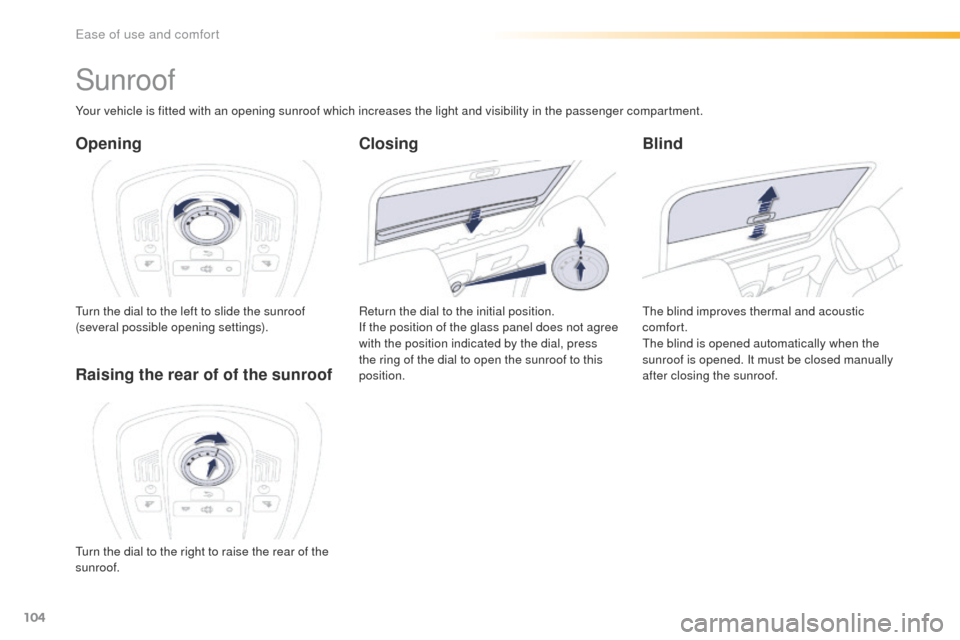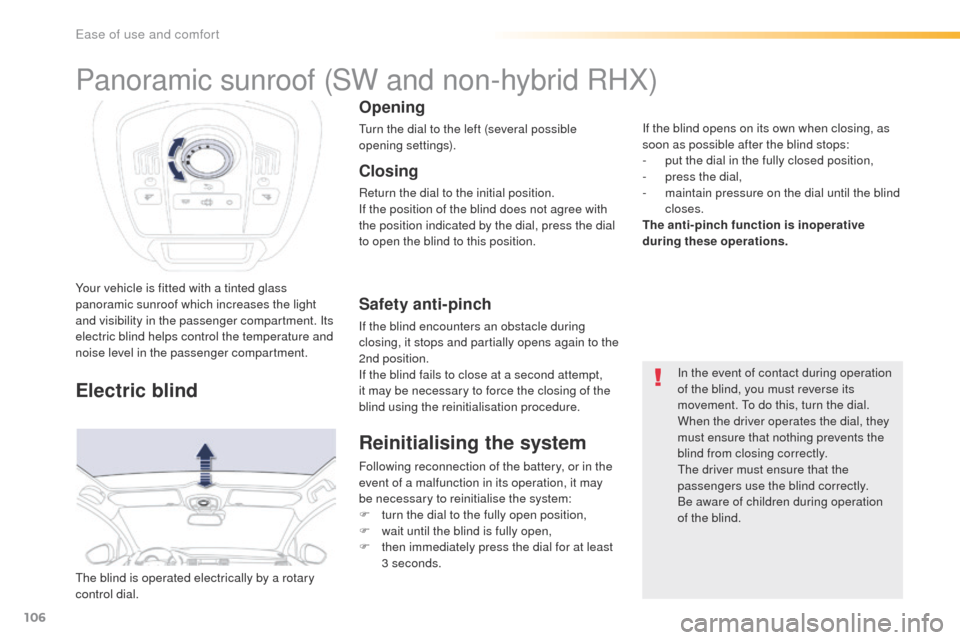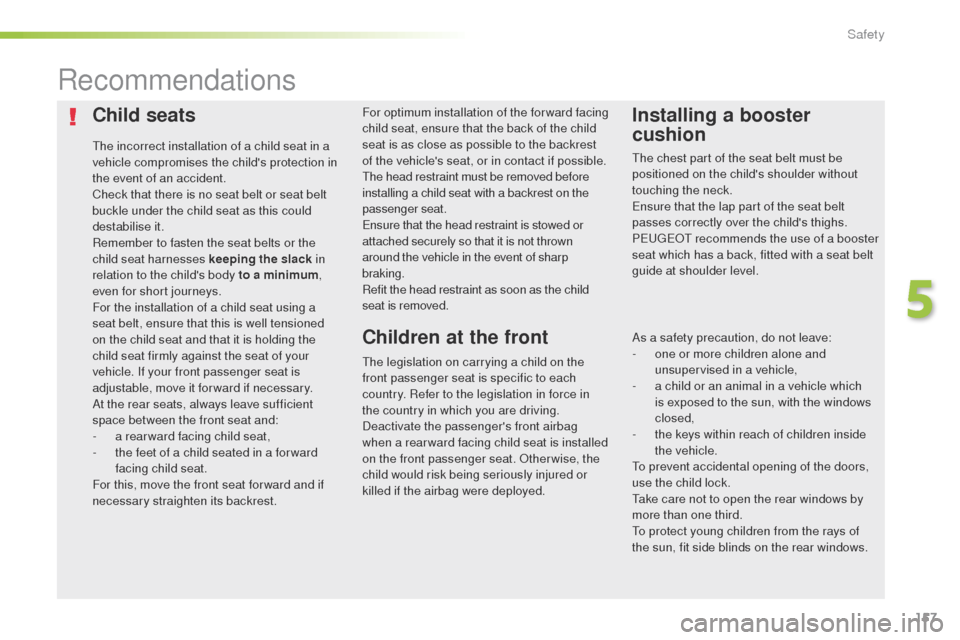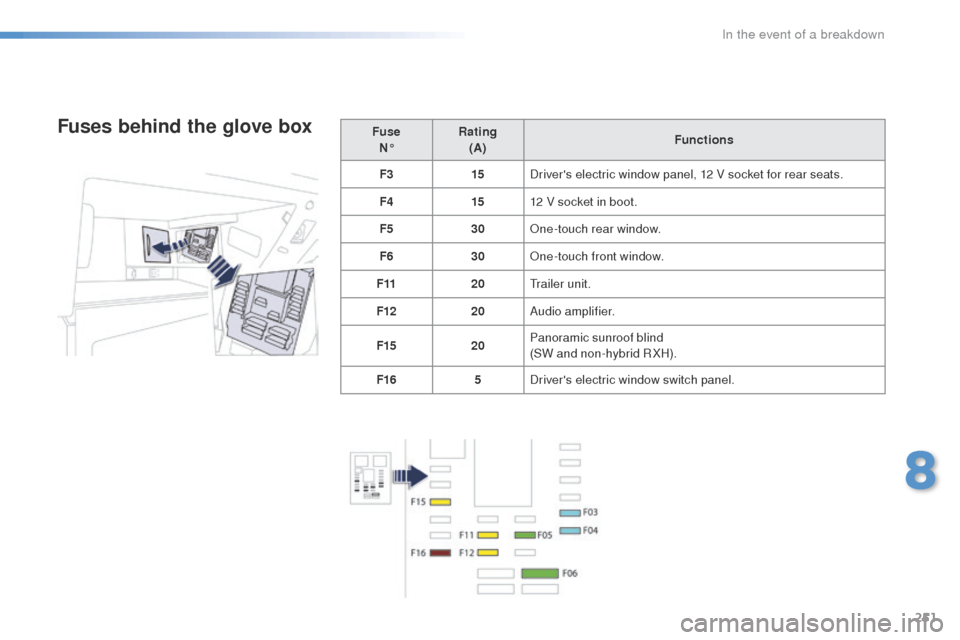2016 Peugeot 508 RXH blind
[x] Cancel search: blindPage 106 of 364

104
508_en_Chap03_ergonomie-et-confort_ed01-2016
Sunroof
Opening
turn the dial to the left to slide the sunroof
(several possible opening settings).
Blind
the blind improves thermal and acoustic
comfort.
the
blind is opened automatically when the
sunroof is opened. It must be closed manually
after closing the sunroof.
Raising the rear of of the sunroof
Your vehicle is fitted with an opening sunroof which increases the light and visibility in the passenger compartment.
Return the dial to the initial position.
If the position of the glass panel does not agree
with the position indicated by the dial, press
the ring of the dial to open the sunroof to this
position.
Closing
turn the dial to the right to raise the rear of the
sunroof.
ease of use and comfort
Page 108 of 364

106
508_en_Chap03_ergonomie-et-confort_ed01-2016
Your vehicle is fitted with a tinted glass
panoramic sunroof which increases the light
and visibility in the passenger compartment. Its
electric blind helps control the temperature and
noise level in the passenger compartment.
th
e blind is operated electrically by a rotary
control dial.
Opening
turn the dial to the left (several possible
opening settings).
Safety anti-pinch
If the blind encounters an obstacle during
closing, it stops and partially opens again to the
2nd position.
If the blind fails to close at a second attempt,
it may be necessary to force the closing of the
blind using the reinitialisation procedure.
Closing
Return the dial to the initial position.
If the position of the blind does not agree with
the position indicated by the dial, press the dial
to open the blind to this position.
Electric blind
In the event of contact during operation
of the blind, you must reverse its
movement.
t
o d
o this, turn the dial.
When the driver operates the dial, they
must ensure that nothing prevents the
blind from closing correctly.
th
e driver must ensure that the
passengers use the blind correctly.
Be aware of children during operation
of the blind.
Reinitialising the system
Following reconnection of the battery, or in the
event of a malfunction in its operation, it may
be necessary to reinitialise the system:
F
t
urn the dial to the fully open position,
F
w
ait until the blind is fully open,
F
t
hen immediately press the dial for at least
3 seconds. If the blind opens on its own when closing, as
soon as possible after the blind stops:
-
p
ut the dial in the fully closed position,
-
p
ress the dial,
-
m
aintain pressure on the dial until the blind
closes.
The anti-pinch function is inoperative
during these operations.
Panoramic sunroof (SW and non-hybrid RHX)
ease of use and comfort
Page 159 of 364

157
508_en_Chap05_securite_ed01-2016
Child seats
the incorrect installation of a child seat in a
vehicle compromises the child's protection in
the event of an accident.
Check that there is no seat belt or seat belt
buckle under the child seat as this could
destabilise it.
Remember to fasten the seat belts or the
child seat harnesses keeping the slack in
relation to the child's body to a minimum,
even for short journeys.
For the installation of a child seat using a
seat belt, ensure that this is well tensioned
on the child seat and that it is holding the
child seat firmly against the seat of your
vehicle. If your front passenger seat is
adjustable, move it forward if necessary.
At the rear seats, always leave sufficient
space between the front seat and:
-
a r
ear ward facing child seat,
-
t
he feet of a child seated in a for ward
facing child seat.
For this, move the front seat for ward and if
necessary straighten its backrest.
Recommendations
Installing a booster
cushion
As a safety precaution, do not leave:
- o ne or more children alone and
unsupervised in a vehicle,
-
a c
hild or an animal in a vehicle which
is exposed to the sun, with the windows
closed,
-
t
he keys within reach of children inside
the vehicle.
to p
revent accidental opening of the doors,
use the child lock.
ta
ke care not to open the rear windows by
more than one third.
to p
rotect young children from the rays of
the sun, fit side blinds on the rear windows.
th
e chest part of the seat belt must be
positioned on the child's shoulder without
touching the neck.
en
sure that the lap part of the seat belt
passes correctly over the child's thighs.
P
e
uge
Ot
recommends the use of a booster
seat which has a back, fitted with a seat belt
guide at shoulder level.
For optimum installation of the forward facing
child seat, ensure that the back of the child
seat is as close as possible to the backrest
of the vehicle's seat, or in contact if possible.
th
e head restraint must be removed before
installing a child seat with a backrest on the
passenger seat.
en
sure that the head restraint is stowed or
attached securely so that it is not thrown
around the vehicle in the event of sharp
braking.
Refit the head restraint as soon as the child
seat is removed.Children at the front
the legislation on carrying a child on the
front passenger seat is specific to each
country. Refer to the legislation in force in
the country in which you are driving.
Deactivate the passenger's front airbag
when a rear ward facing child seat is installed
on the front passenger seat. Otherwise, the
child would risk being seriously injured or
killed if the airbag were deployed.
5
Safety
Page 195 of 364

193
508_en_Chap06_conduite_ed01-2016
this system indicates the proximity of an
obstacle (person, vehicle, tree, gate, etc.)
which comes within the field of detection of
sensors located in the bumper.
Certain types of obstacle (stake, roadworks
cone, etc.) detected initially will no longer be
detected at the end of the manoeuvre, if they
are located in blind spots in the sensors' field
of detection.
Parking sensors
this system cannot in any circumstances replace
the need for vigilance on the part of the driver.
the system is switched on by engaging reverse
g e a r.
th
is is confirmed by an audible signal.
th
e system is switched off when you come out
of reverse gear.
Rear parking sensors
Audible assistance
the proximity information is given by an
intermittent audible signal, the frequency of which
increases as the vehicle approaches the obstacle.
th
e sound emitted by the speaker (right or left)
indicates the side on which the obstacle is located.
When the distance between the vehicle and
the obstacle becomes less than approximately
thirty centimetres, the audible signal becomes
continuous.
Visual assistance
this supplements the audible signal by
displaying bars in the screen which move
progressively nearer to the vehicle.
When the obstacle is very close, the "Danger"
symbol is displayed in the screen.
6
Driving
Page 198 of 364

196
508_en_Chap06_conduite_ed01-2016
Blind spot monitoring system
this driving assistance system warns the driver
of the presence of another vehicle in the blind
spot angle of their vehicle (areas masked from
the driver's field of vision), as soon as this
presents a potential danger.A warning lamp appears in the door mirror on
the side in question:
-
i
mmediately, when being overtaken,
-
a
fter a delay of about one second, when
overtaking a vehicle slowly.
th
is system is designed to improve
safety when driving and is in no
circumstances a substitute for the use
of the interior rear view mirror and door
mirrors. It is the driver's responsibility to
constantly check the traffic, to assess
the distances and relative speeds
of other vehicles and to predict their
movements before deciding whether to
change lane.
th
e blind spot sensor system can never
replace the need for vigilance on the
part of the driver.
Driving
Page 199 of 364

197
508_en_Chap06_conduite_ed01-2016
No alert will be given in the following situations:
- i n the presence of immobile objects
(parked vehicles, barriers, street lamps,
road signs...),
-
w
ith vehicles moving in the opposite
direction,
-
d
riving on a sinuous road or a sharp
c o r n e r,
Sensors fitted in the front and rear bumpers
monitor the blind spots.
th
e alert is given by a warning lamp which
comes on in the door mirror on the side in
question as soon as a vehicle - car, lorry,
cycle
- is detected.
For this, the following conditions must be met:
-
a
ll the vehicles must be moving in the
same direction,
-
t
he speed of your vehicle is between 7 and
75 mph (12 and 140 km/h),
-
w
hen you overtake a vehicle with a speed
difference of less than 6 mph (10 km/h),
-
w
hen a vehicle overtakes you with a speed
difference of less than 15 mph (25 km/h),
-
t
he traffic must be flowing normally,
-
i
n the case of an overtaking manoeuvre,
if this is prolonged and the vehicle being
overtaken remains in the blind spot,
-
y
ou are driving on a straight or slightly
curved road,
-
y
our vehicle is not pulling a trailer,
a
caravan...
Operation
F On switching on the ignition, or engine running, press this button
to activate the function; the
warning lamp comes on.
With audio system or for HYbrid4 version
With touch screen
6
Driving
Page 200 of 364

198
508_en_Chap06_conduite_ed01-2016
- when overtaking (or being overtaken by) a very long vehicle (lorry, coach...) which is
at the same time detected at the rear in the
blind spot angle and present in the driver's
forward field of vision,
-
i
n very heavy traffic: vehicles detected in
front and behind are confused with a lorry
or a stationary object,
-
w
hen overtaking quickly. F
t
o d
eactivate the system, press
this button again; the warning
lamp goes off.
Operating fault
the system may suffer temporary
interference in certain weather
conditions (rain, hail...).
In particular, driving on a wet sur face
or moving from a dry area to a wet area
can cause false alerts (for example, the
presence of a fog of water droplets in
the blind spot angle is interpreted as a
vehicle).
In bad or wintry weather, ensure that
the sensors are not covered by mud, ice
or snow.
ta
ke care not to cover the warning zone
in the door mirrors or the detection
zones on the front and rear bumpers
with adhesive labels or other objects;
they may hamper the correct operation
of the system. In the event of a fault, the warning
lamp in the button flashes then
goes
off.
Have it checked by a P
e
uge
Ot
dealer or a
qualified workshop.
th
e state of the system remains in memory on
switching off the ignition.
th
e system is automatically deactivated
when towing with a towbar approved by
P
e
u g e
Ot
.
Driving
Page 253 of 364

251
508_en_Chap08_en-cas-de-pannes_ed01-2016
Fuse N° Rating
(A) Functions
F3 15Driver's electric window panel, 12 V socket for rear seats.
F4 1512 V socket in boot.
F5 30One-touch rear window.
F6 30One-touch front window.
F11 20
tr
ailer unit.
F12 20Audio amplifier.
F15 20Panoramic sunroof blind
(SW and non-hybrid R XH).
F16 5Driver's electric window switch panel.Fuses behind the glove box
8
In the event of a breakdown